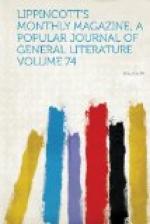Of its fourteen original members but two survive, the duc de Nemours and M. Ernest Leroy. The other twelve were His Royal Highness the duc d’Orleans, M. Rieussec, who was killed by the infernal machine of Fieschi, the comte de Cambis, equerry to the duc d’Orleans, Count Demidoff, Fasquel, the chevalier de Machado, the prince de la Moskowa, M. de Normandie, Lord Henry Seymour, Achille Delamarre, Charles Lafitte and Caccia. To these fourteen gentlemen were soon added others of the highest rank or of the first position in the aristocratic world of Paris. People began to talk with bated breath of the Jockey Club and of its doings, and strange stories were whispered of the habits of some of its distinguished members. The eccentricities of Count Demidoff and of Major Frazer, the obstreperous fooleries of Lord Henry Seymour, the studied extravagances of Comte d’Alton-Shee, created in the public mind the impression that the club was nothing less than a sort of infernal pit, peopled by wicked dandies like Balzac’s De Marsay, Maxime de Trailles, Rastignac, etc. Even the box of the club at the opera was dubbed with the uncanny nickname loge infernale, and the talk of the town ran upon the frightful sums lost and won every night at the tables of the exclusive cercle, while the nocturnal passer-by pointed with a shudder to the windows of the first floor at the corner of the Rue de Grammont and the Boulevard, glimmering until morning dawn with a light altogether satanic. The truth must be confessed that jeunesse doree of the period affected a style somewhat “loud.” There was exaggeration in everything—in literature—for it was the epoch of the great romantic impulse—in art, in politics: what wonder, then, that the distractions of high life should over-pass the boundaries of good taste, and even of propriety? The Jockey Club in the time of Louis Philippe did but recall the good old days of Brookes’s and of White’s, of the two Foxes, of George Selwyn and of Sheridan. But how changed is all this! There is not to-day in Paris, perhaps in the world, a more sedate, reputable and in every sense temperate club than the “Jockey.” It concerns itself only with racing, the legitimate object of its foundation, and nothing else is discussed




